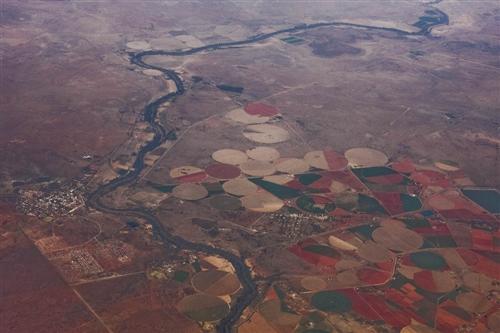In many rivers, dams and also aquifers of the Orange-Senqu River basin eutrophication with nitrates and phosphates is increasing. These substances pollute both rivers and reservoirs, especially in areas like the Vaal River basin that contain a lot of capital-intensive industries, agriculture and poor settlements. This can have dramatic consequences.
Common substances
Nitrates and phosphates are in common use. Many meat products are preserved with nitrates; phosphates are found in milk and cheese products; and in South Africa, unlike the European Union, phosphates are still approved as active ingredients in detergents. Moreover, the two substances are found naturally in a number of different soils and count among the most important components of agricultural fertiliser products. Natural sources of both substances are the excrement of animals and humans.
The main factors contributing to eutrophication are:
-
Silt loads resulting from soil erosion in the upper reaches of the rivers.
-
Agricultural return flow, especially along the lower reaches of the Vaal and Orange.
-
Malfunctioning water treatment plants and sewage/organic waste getting directly into waterbodies.
-
Excrement of millions of cattle and other livestock across the basin.
Box: Nutrient Concentrations in the River Basin
Nutrient concentrations throughout most of the Basin are sufficiently high to cause algal blooms. However, concentrations in the middle and lower reaches of the Vaal and Riet Rivers are noticeably higher than those typical of the rest of the basin. Total phosphorus concentrations along this stretch of river range from 1.0 - 5.0 mg/L. Major algal blooms have been noted along this entire stretch, resulting in substantial problems with the treatment of water.
Nutrient concentrations further upstream in the Vaal and Wilge Rivers are much lower at 0.1 mg/L total phosphate. Suggesting that urban pollution from the southern Gauteng area is a major source of increased nutrient concentrations.
Total phosphorus concentrations in rivers in the Lesotho Highlands are typically below 0.03mg/L, while those in the Senqu River just before it flows into South Africa were 1.7 mg/L due to the high sediment loads at the time of sampling. Nutrient concentrations in the Caledon / Mohakare River increase downstream of Maseru. This may however also be partly associated with a rainfall event just before sampling.
Total phosphate concentrations further downstream in the Orange River range from less than 0.2 mg/L to 0.5 mg/L, while concentrations in the lower Orange River range from 0.2-0.7 mg/L. However, total phosphorus to total nitrogen ratios tend to be higher in this part of the system, suggesting that the nutrients come from agricultural fertilisers. Very high nitrogen concentrations in the groundwater in Namibia are typical of underground water in agricultural areas.
To access an overview of the water quality situation in the Orange-Senqu River basin, please consultant the: "The State of the Orange Senqu River system – A Report on ORASECOM‘s First Joint Basin Survey JBS-1, Centurion 2011", in the Document Library.
Immediate dangers
High levels of nitrates in water are very dangerous for cattle drinking this water. Many cattle are kept near water holes that are already rich in nitrates, and their excrement raises the levels still further. When the cattle drink the water, bacteria from their digestion process convert the nitrate into highly toxic nitrite, which lowers their blood’s ability to absorb oxygen. The cattle literally suffocate from inside – a phenomenon experienced by numbers of farmers in South Africa, Namibia and Botswana. This nitrite poisoning can also have deadly effects on human infants who still have developing intestinal flora. In such cases, it is called methemoglobinemia, or ‘blue baby syndrome’.
Besides that, of course, nitrates and phosphates stimulate plant growth. It’s especially noticeable in the growth of water hyacinth and algal blooms. The health threats resulting from blooms of blue-green algae are discussed on the following page - Microcystines.

Agriculutre runoff can impact water quality.
Source:Ramon 2008
( click to enlarge )
